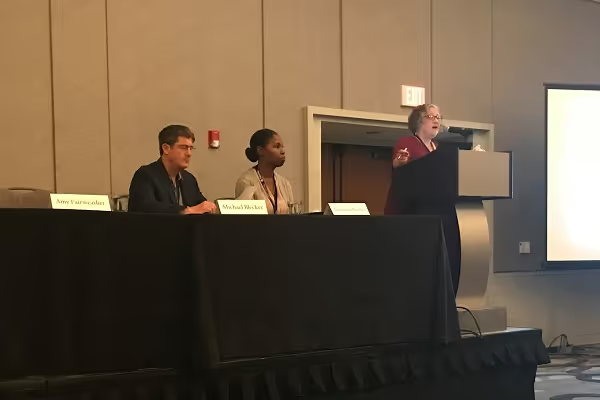Last week’s National Coalition for Homeless Veterans (NCHV) 2018 Conference was built around the theme “Progress. Practice. Perseverance.” And Swords to Plowshares came to work. Seven staff flew to Washington, D.C. to deliver presentations on aging veterans and our signature Combat to Community® training for social service providers, to network with amazing leaders from all parts of the country, and to meet with lawmakers to discuss our mission to end veteran homelessness.
But there was worry in all the faces in the room. For the first time since the national effort to end homelessness was announced, we were forced to confront that last year there was a rise in veteran homelessness. “It’s easy to feel discouraged when you see that number tick up,” Kathryn Monet, chief executive officer for NCHV stated. “It’s a setback for the movement. But we don’t want to lose sight of what we have accomplished across the country. We don’t want to look at this number and say that we’ll never get there.”
Secretary of Housing and Urban Development, Ben Carson, opened the conference, and claimed if you remove Los Angeles County from the equation, then veteran homelessness decreased last year. Los Angeles County has the highest number of homeless veterans than anywhere else in the country; to remove them from the equation disregards roughly 5,000 veterans. A dismissal of hard-to-serve areas and populations sparked a flicker of unease felt throughout the conference.
Overall, conversations among providers were very localized to our own communities. And that makes sense: that’s where our efforts are focused as we get to a functional zero. Initiatives like the Mayors Challenge bring local governments and community providers together in a common mission. Since June of 2014, more than 880 mayors, city and county officials, and governors have joined the Mayors Challenge. 63 communities across 33 different states have achieved the goal. While we must start in our own communities, local efforts like these can also decentralize the national effort and the overall message. It brings responsibility to individual communities, rather than the community at large. It’s what brought many to say during the conference, “Los Angeles aside, we’re doing a great job.” But Los Angeles and other cities, including San Francisco, which grapple with wealth inequality, struggle to house veterans in our communities amid a lack of affordable and accessible housing. California has experienced a 17 percent rise in homeless veterans since 2016. It makes us forget that if we don’t eliminate veteran homelessness in every community, we won’t end homelessness.
WHAT DOES IT TAKE TO END VETERAN HOMELESSNESS?
- We must focus on hard-to-serve areas, especially Los Angeles County where there is a rise in first-time homelessness. We must target the lack of accessible and affordable housing through increased housing subsidies, and the lack of landlords willing to rent to homeless veterans through progressive landlord engagement.
- We must concentrate on hard-to-serve populations, including veterans ineligible or otherwise outside of VA-funded homeless programs, and encourage the VA to adopt a more holistic approach when determining whether a veteran is eligible for benefits. Veterans with bad paper are seven times more likely to end up homeless.
- We need to more effectively serve aging veterans, who constitute the greatest portion of veteran homeless, so they can age-in-place in their communities. Michael Blecker, Tramecia Garner, and Amy Fairweather from Swords to Plowshares presented on the growing number of aging veteran homeless, a population that expresses frailties far beyond their actual age. Providing in-home supportive services, accessible housing, and decreasing isolation is key to serving this population.
- We need to increase connections to education and employment, such as Home Depot Foundation’s latest initiative that Heather Prill, Strategic Partnerships and Hometown Giving, discussed during the conference, which aims to place 20,000 people in skilled trades by 2028.
- We need to examine the overlap of homelessness and suicide, incarceration, and inter-partner violence (IPV). Researchers cited their latest studies during a listening session at the conference: six percent of homeless veterans complete suicide after showing up for VA housing services, women veterans who experience IPV are three times as likely to become homeless, and up to eight percent of veterans who exit HUD-VASH programs become incarcerated. During a panel with federal partners, Leon Winston, our chief operating officer, brought to the attention of Steve Berg from National Alliance to End Homelessness that veterans entering jail and prison immediately have their VA benefits stripped to 10 percent, but upon exiting jail and prison, the restoration of benefits takes over a year.
- We need to apply new technologies in every community, like the By-Name List that KO Campbell and Garen Nigon from Community Solutions presented, a master list generation tool that can capture real-time data on veteran homelessness, define goals for the community, and calculate benchmarks.
- We need to look at how we treat and serve veterans of color who fall into homelessness more often than white non-Hispanic veterans. We need to look deeply at ourselves, within our programs and services, to change unintentional bias, and ensure equitable housing development throughout the country. Amanda Andere from Funders Together to End Homelessness spoke on issues and trends in race and homelessness, citing Black veterans make up one in three homeless veterans, while overall, they are one in eleven veterans. Previously, even though Native Americans serve in the U.S. military at a higher percentage than any other ethnic group and have since the Revolution, tribes and tribal housing authorities were unable to access federal veteran housing funds. A pilot project was set up in 2015, and the Senate just passed The Tribal HUD-VASH Act,which authorizes and will provide stability to the Tribal HUD-VASH initiative to ensure Native communities can sustain their veteran outreach work. The bill is now going on to the House for a vote.
- We need to strengthen and sustain the U.S. Interagency Council on Homelessness (USICH), which plays a significant role in bringing VA and HUD together, setting federal benchmarks and focusing collaborative efforts. As Leon Winston from Swords to Plowshares and Joshua Stewart from NCHV stated during a panel on public policy, the small but extremely effective USICH staff need to be there until we solve veteran homelessness. S. 743, a bill to permanently authorize USICH, is currently in the Senate, and there is no current effort in the House for such a bill.
As Bev Ebersold from USICH stated, “Getting to functional zero doesn’t mean taking our foot off the gas. We must continually assess and improve our efforts. That means reaching every hard-to-serve area, and every underrepresented population.”


.png)
.png)


